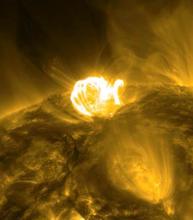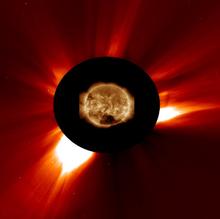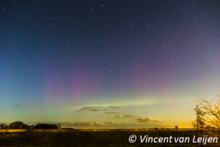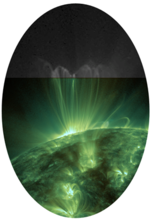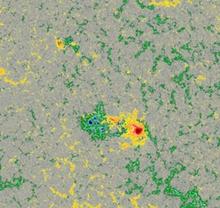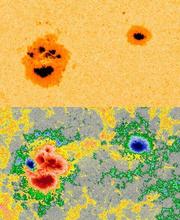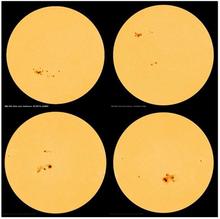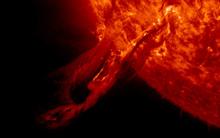news
Submitted on 2015-01-28
Over the last few weeks, sky gazers have been enjoying a relatively bright and colorful comet in the northern skies. Comet Lovejoy, named after its discoverer Terry Lovejoy (Australia), has been the source of many beautiful pictures that can be admired on the web (see e.g. Spaceweather.com comet gallery).

Submitted on 2015-01-22
During the morning hours of 13 January, a rather strong M-class flare took place in active region NOAA 2257, close to the northwest limb. This sunspot group seemed deceptively simple, but harboured some opposite magnetic polarity spots close to each other. That's a configuration that often results in a flare.

Submitted on 2015-01-14
On 7 January, a strong geomagnetic storm (Kp=7; see the NOAA scales) was observed. The solar wind magnetic field turned southward with maximum values of -21 nT, which is even a bit stronger than the 12 September storm from last year (-18 nT; see this news item).

Submitted on 2015-01-09
Well, maybe it was a bit late to spectacularly launch the New Year, but at least in the northern part of the Netherlands some faint but colorful polar light could be seen low above the northern horizon on 4 January around 18:00UT. The aurora didn't last long, barely 10 minutes, but Vincent van Leijen still managed to snap this great picture.

Submitted on 2014-12-30
In its New Year's letter for 2014, the Sun promised great solar activity to come. True to its word, sunspot numbers reached a new monthly high in February 2014, probably indicating the maximum of the ongoing solar cycle. Throughout the year, this increased sunspot activity was accompanied by plenty of strong flares, big sunspot groups and geomagnetic unrest.
Submitted on 2014-12-12
If you are looking for solar, solar wind, and earth environment data at a glance and you want to see them on a timeline, even if you are not a computer expert: STAFF has it all.

Submitted on 2014-11-26
With only one more month to go in 2014, huge NOAA 2192 is very probably going to be *the* sunspot group of the year. After its impressive performance just a few weeks ago (see this news item), observers and forecasters were counting down to its re-appearance at the solar east limb. NOAA 2192 obliged by starting its encore performance on 12 November, getting itself a new name: NOAA 2209. Unfortunately, as is sometimes the case with sequels of blockbusters, this group did not live up to the expectations.
Submitted on 2014-11-13
We are now close to 6 years since solar cycle 24 (SC24) started the gradual climb towards its solar cycle maximum. Over the last year, solar activity was mostly elevated, with several X-class flares and large sunspot groups. As the sunspot activity varies from month to month, the monthly sunspot numbers are smoothed to get an idea of the overall evolution. It then appears, pending the smoothing formula used, that a solar cycle maximum occurred during the early spring months of 2014 (red curve in graph underneath).
Submitted on 2014-11-05
Solar filaments are clouds of ionized gas above the solar surface squeezed between magnetic regions of opposite polarity. Being cooler and denser than the plasma underneath and their surroundings, they appear as dark lines when seen on the solar disk using special filters. At the solar limb, the same features shine bright over the solar limb and are called prominences. As filaments grow longer, they are more likely to erupt, often accompanied by a coronal mass ejection (CME).

Pages
Zircon - This is a contributing Drupal Theme
Design by
WeebPal.



